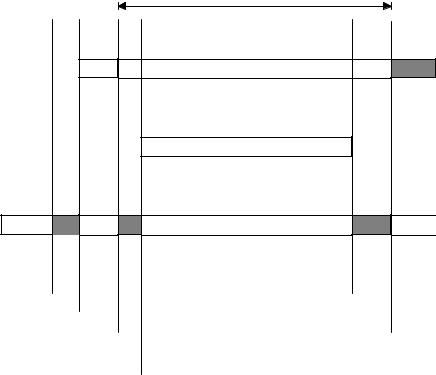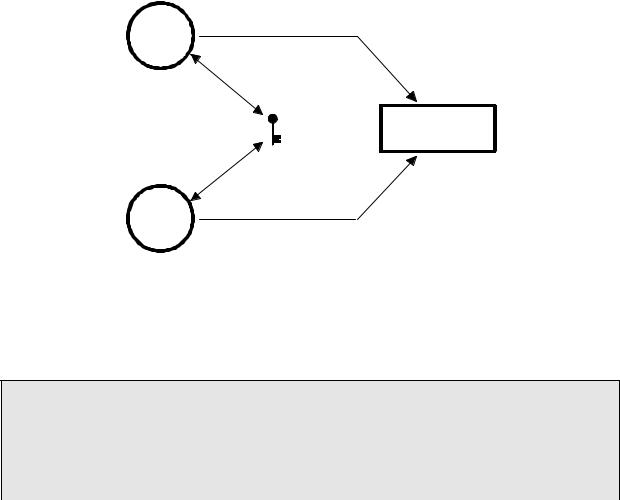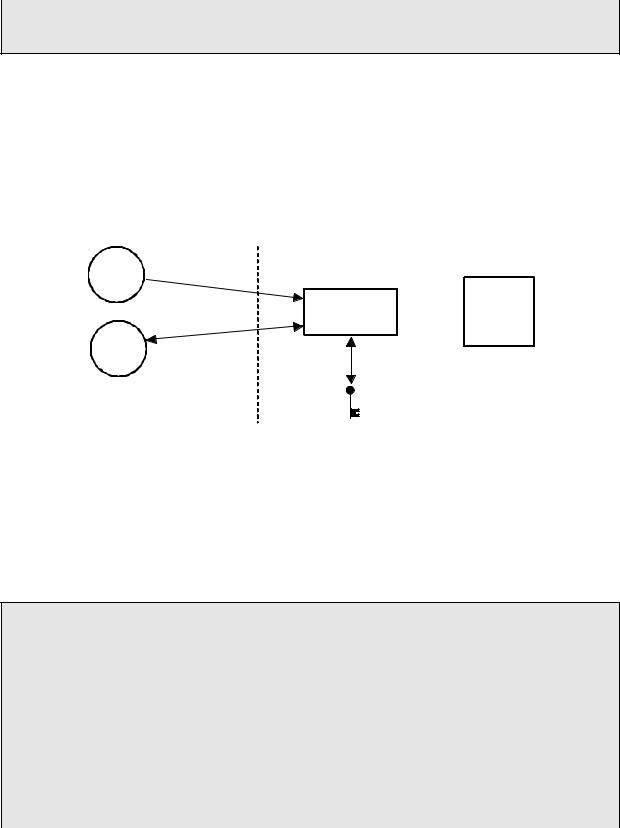
- •Preface
- •Introduction
- •1.01 INCLUDES.H
- •1.02 Compiler Independent Data Types
- •1.03 Global Variables
- •1.04 OS_ENTER_CRITICAL() and OS_EXIT_CRITICAL()
- •1.05 PC Based Services
- •1.05.01 PC Based Services, Character Based Display
- •1.05.02 PC Based Services, Elapsed Time Measurement
- •1.05.03 PC Based Services, Miscellaneous
- •1.07 Example #1
- •1.08 Example #2
- •1.09 Example #3
- •2.00 Foreground/Background Systems
- •2.01 Critical Section of Code
- •2.02 Resource
- •2.03 Shared Resource
- •2.04 Multitasking
- •2.05 Task
- •2.06 Context Switch (or Task Switch)
- •2.07 Kernel
- •2.08 Scheduler
- •2.09 Non-Preemptive Kernel
- •2.10 Preemptive Kernel
- •2.11 Reentrancy
- •2.12 Round Robin Scheduling
- •2.13 Task Priority
- •2.14 Static Priorities
- •2.15 Dynamic Priorities
- •2.16 Priority Inversions
- •2.17 Assigning Task Priorities
- •2.19 Mutual Exclusion
- •2.20 Deadlock (or Deadly Embrace)
- •2.21 Synchronization
- •2.22 Event Flags
- •2.23 Intertask Communication
- •2.24 Message Mailboxes
- •2.25 Message Queues
- •2.26 Interrupts
- •2.27 Interrupt Latency
- •2.28 Interrupt Response
- •2.29 Interrupt Recovery
- •2.30 Interrupt Latency, Response, and Recovery
- •2.31 ISR Processing Time
- •2.32 Non-Maskable Interrupts (NMIs)
- •2.33 Clock Tick
- •2.34 Memory Requirements
- •2.35 Advantages and Disadvantages of Real-Time Kernels
- •2.36 Real-Time Systems Summary
- •3.00 Critical Sections
- •3.01 Tasks
- •3.02 Task States
- •3.03 Task Control Blocks (OS_TCBs)
- •3.04 Ready List
- •3.05 Task Scheduling
- •3.06 Locking and Unlocking the Scheduler
- •3.07 Idle Task
- •3.08 Statistics Task
- •3.10 Clock Tick
- •3.14 OSEvent???() functions
- •4.00 Creating a Task, OSTaskCreate()
- •4.01 Creating a Task, OSTaskCreateExt()
- •4.02 Task Stacks
- •4.03 Stack Checking, OSTaskStkChk()
- •4.04 Deleting a Task, OSTaskDel()
- •4.05 Requesting to delete a task, OSTaskDelReq()
- •4.06 Changing a Task’s Priority, OSTaskChangePrio()
- •4.07 Suspending a Task, OSTaskSuspend()
- •4.08 Resuming a Task, OSTaskResume()
- •4.09 Getting Information about a Task, OSTaskQuery()
- •5.00 Delaying a task, OSTimeDly()
- •5.01 Delaying a task, OSTimeDlyHMSM()
- •5.02 Resuming a delayed task, OSTimeDlyResume()
- •5.03 System time, OSTimeGet() and OSTimeSet()
- •6.00 Event Control Blocks
- •6.01 Initializing an ECB, OSEventWaitListInit()
- •6.02 Making a task ready, OSEventTaskRdy()
- •6.03 Making a task wait for an event, OSEventTaskWait()
- •6.04 Making a task ready because of a timeout, OSEventTO()
- •6.05 Semaphores
- •6.06 Message Mailboxes
- •6.07 Message Queues
- •7.00 Memory Control Blocks
- •7.01 Creating a partition, OSMemCreate()
- •7.02 Obtaining a memory block, OSMemGet()
- •7.03 Returning a memory block, OSMemPut()
- •7.04 Obtaining status about memory partition, OSMemQuery()
- •7.05 Using memory partitions
- •7.06 Waiting for memory blocks from a partition
- •8.00 Development Tools
- •8.01 Directories and Files
- •8.02 INCLUDES.H
- •9.00 Development Tools
- •9.01 Directories and Files
- •9.02 INCLUDES.H
- •9.06 Memory requirements
- •9.07 Execution times
- •10.00 Directories and Files
- •10.01 INCLUDES.H
- •10.02.01 OS_CPU.H, Compiler specific data types
- •10.02.02 OS_CPU.H, OS_ENTER_CRITICAL() and OS_EXIT_CRITICAL()
- •10.02.03 OS_CPU.H, OS_STK_GROWTH
- •10.02.04 OS_CPU.H, OS_TASK_SW()
- •10.03.01 OS_CPU_A.ASM, OSStartHighRdy()
- •10.03.02 OS_CPU_A.ASM, OSCtxSw()
- •10.03.03 OS_CPU_A.ASM, OSIntCtxSw()
- •10.03.04 OS_CPU_A.ASM, OSTickISR()
- •10.04.01 OS_CPU_C.C, OSTaskStkInit()
- •10.04.02 OS_CPU_C.C, OSTaskCreateHook()
- •10.04.03 OS_CPU_C.C, OSTaskDelHook()
- •10.04.04 OS_CPU_C.C, OSTaskSwHook()
- •10.04.05 OS_CPU_C.C, OSTaskStatHook()
- •10.04.06 OS_CPU_C.C, OSTimeTickHook()
- •10.05 Summary
- •OSInit()
- •OSIntEnter()
- •OSIntExit()
- •OSMboxAccept()
- •OSMboxCreate()
- •OSMboxPend()
- •OSMboxPost()
- •OSMboxQuery()
- •OSMemCreate()
- •OSMemGet()
- •OSMemPut()
- •OSMemQuery()
- •OSQAccept()
- •OSQCreate()
- •OSQFlush()
- •OSQPend()
- •OSQPost()
- •OSQPostFront()
- •OSQQuery()
- •OSSchedLock()
- •OSSchedUnlock()
- •OSSemAccept()
- •OSSemCreate()
- •OSSemPend()
- •OSSemPost()
- •OSSemQuery()
- •OSStart()
- •OSStatInit()
- •OSTaskChangePrio()
- •OSTaskCreate()
- •OSTaskCreateExt()
- •OSTaskDel()
- •OSTaskDelReq()
- •OSTaskResume()
- •OSTaskStkChk()
- •OSTaskSuspend()
- •OSTaskQuery()
- •OSTimeDly()
- •OSTimeDlyHMSM()
- •OSTimeDlyResume()
- •OSTimeGet()
- •OSTimeSet()
- •OSTimeTick()
- •OSVersion()
a)Declare Temp local to swap().
b)Disable interrupts before the operation and enable them after.
c)Use a semaphore (described later).
If the interrupt occurs either before or after swap(), the x and y values for both tasks will be correct.
2.12 Round Robin Scheduling
When two or more tasks have the same priority, the kernel will allow one task to run for a predetermined amount of time, called aquantum, and then selects another task. This is also called time slicing. The kernel gives control to the next task in line if:
a)the current task doesn't have any work to do during its time slice or
b)the current task completes before the end of its time slice.
µC/OS-II does not currently support round -robin scheduling. Each task must have a unique priority in your application.
2.13 Task Priority
A priority is assigned to each task. The more important the task, the higher the priority given to it.
2.14 Static Priorities
Task priorities are said to be static when the priority of each task does not change during the application's execution. Each task is thus given a fixed priority at compile time. All the tasks and their timing constraints are known at compile time in a system where priorities are static.
2.15 Dynamic Priorities
Task priorities are said to be dynamic if the priority of tasks can be changed during the application's execution; each task can change its priority at run-time. This is a desirable feature to have in a real-time kernel to avoid priority inversions.
2.16 Priority Inversions
Priority inversion is a problem in real-time systems and occurs mostly when you use a real-time kernel. Figure 2-7 illustrates a priority inversion scenario. Task#1 has a higher priority than Task#2 which in turn has a higher priority than Task#3. Task#1 and Task#2 are both waiting for an event to occur and thus, Task#3 is executing F2 -7(1). At some point, Task#3 acquires a semaphore (see section 2.18, Semaphores) that it needs before it can access a shared resource F2-7(2). Task#3 performs some operations on the acquired resource F2 -7(3) until it gets preempted by the high priority task, Task#1 F2-7(4). Task#1 executes for a while until it also wants to access the resource F2 -7(5). Because Task#3 owns the resource, Task#1 will have to wait until Task#3 releases the semaphore. As Task#1 tries to get the semaphore, the kernel notices that the semaphore is already owned and thus, Task#1 gets suspended and Task#3 is resumed F2-7(6). Tas k#3 continues execution until it gets preempted by Task#2 because the event that Task#2 was waiting for occurred F2-7(7). Task #2 handles the event F2-7(8) and when it’s done, Task#2 relinquishes the CPU back to Task#3 F2-7(9). Task#3 finishes working with the resource F2-7(10) and thus, releases the semaphore F2-7(11). At this point, the kernel knows that a higher priority task is waiting for the semaphore and, a context switch is done to resume Task#1. At this point, Task#1 has the semaphore and can thus access the shared resource F2-7(12).
The priority of Task#1 has been virtually reduced to that of Task#3’s because it was waiting for the resource that Task#3 owned. The situation got aggravated when Task#2 preempted Task#3 which further delayed the execution of Task#1.
You can correct this situation by raising the priority of Task#3 (above the priority of the other tasks competing for the resource) for the time Task#3 is accessing the resource and restore the original priority level when the task is finished.

A multitasking kernel should allow task priorities to change dynamically to help prevent priority inversions. It takes, however, some time to change a task’s priority. What if Task#3 had completed access of the resource before it got preemp ted by Task#1 and then by Task#2? Had we raised the priority of Task#3 before accessing the resource and then lowered it back when done, we would have wasted valuable CPU time. What is really needed to avoid priority inversion is a kernel that changes the priority of a task automatically. This is called priority inheritance , and unfortunately µC/OS-II doesn’t support this feature. There are, however, some commercial kernels that do.
Priority Inversion
(4) |
(12) |
Task 1 (H)
(8)
Task 2 (M)
(1) |
(6) |
(10) |
Task 3 (L)
Task 3 Get Semaphore |
|
(2) |
Task 3 Resumes |
Task 1 Preempts Task 3 |
(9) |
|
|
(3) |
|
Task 1 Tries to get Semaphore |
Task 3 Releases the Semaphore |
(5) |
(11) |
|
Task 2 Preempts Task 3 |
|
(7) |
Figure 2-7, Priority inversion problem.
Figure 2-8 illustrates what happens when a kernel supports priority inheritance. As with the previous example, Task#3 is running F2 -8(1) and then acquires a semaphore to access a shared resource F2-8(2). Task#3 accesses the resource F2-8(3) and then gets preempted by Task#1 F2-8(4). Task#1 executes F2-8(5) and then tries to obtain the semaphore F2-8(6). The kernel sees that Task#3 has the semaphore but has a lower priority than Task#1. In this case, the kernel raises the priority of Task#3 to the same level as Task#1. The kernel then switches back to Task#3 so that this task can continue with the resource F2 -8(7). When Task#3 is done with the resource, it releases the semaphore F2-8(8). At this point, the kernel reduces the priority of Task#3 to its original value and gives the semaphore to Task#1 which is now free to continue F2-8(9). When Task#1 is done executing F2-8(10), the medium priority task (i.e. Task#2) gets the CPU F2-8(11). Note that Task#2 could have been ready-to-run anytime between F2-8(3) and F2-8(10) without affecting the outcome. There is still some level of priority inversion but, this really cannot be avoided.

Priority Inversion
(5) |
(9) |
Task 1 (H)
(11)
Task 2 (M)
(1) |
(3) |
(7) |
Task 3 (L)
Task 3 Get Semaphore
(2)
Task 1 Preempts Task 3
(4)
Task 1 Tries to get Semaphore (Priority of Task 3 is raised to Task 1's)
(6)
Task 1 Completes
(10)
Task 3 Releases the Semaphore
(Task 1 Resumes)
(8)
Figure 2-8, Kernel that supports priority inheritance.
2.17 Assigning Task Priorities
Assigning task priorities is not a trivial undertaking because of the complex nature of real-time systems. In most systems, not all tasks are considered critical. Non-critical tasks should obviously be given low priorities. Most real-time systems have a combination of SOFT and HARD requirements. In a SOFT real-time system, tasks are performed by the system as quickly as possible, but they don't have to finish by specific times. In HARD real-time systems, tasks have to be performed not only correctly but on time.
An interesting technique called Rate Monotonic Scheduling (RMS) has been established to assign task priorities based on how often tasks execute. Simply put, tasks with the highest rate of execution are given the highest priority (see Figure 2-9).
RMS makes a number of assumptions:
1.All tasks are periodic (they occur at regular intervals).
2.Tasks do not synchronize with one another, share resources, or exchange data.
3.The CPU must always execute the highest priority task that is ready to run. In other words, preemptive scheduling must be used.
Given a set of n tasks that are assigned RMS priorities, the basic RMS theorem states that all task HARD real-time deadlines will always be met if the following inequality is verified:
å |
Ei |
|
æ |
|
1 |
ö |
£ n ´ |
ç |
2 |
n |
÷ |
||
Ti |
ç |
|
-1÷ |
|||
i |
|
è |
|
|
ø |

Equation 2.1
where, Ei corresponds to the maximum execution time of task i and Ti corresponds to the execution period of task i. In other words, Ei/Ti corresponds to the fraction of CPU time required to execute task i. Table 2.1 shows the value for size n(21/n-1) based on the number of tasks. The upper bound for an infinite number of tasks is given by ln(2) or 0.693. This means that to meet all HARD real-time deadlines based on RMS, CPU utilization of all time-critical tasks should be less than 70 percent! Note that you can still have non-time-critical tasks in a system and thus use 100 percent of the CPU's time. Using 100 percent of your CPU's time is not a desirable goal because it does not allow for code changes and added features. As a rule of thumb, you should always design a system to use less than 60 to 70 percent of your CPU.
Number of Tasks |
n(21/n-1) |
1 |
1.000 |
2 |
0.828 |
3 |
0.779 |
4 |
0.756 |
5 |
0.743 |
. |
. |
. |
. |
. |
. |
Infinity |
0.693 |
Table 2.1
RMS says that the highest-rate task has the highest priority. In some cases, the highest-rate task may not be the most important task. Your application will thus dictate how you need to assign priorities. RMS is, however, an interesting starting point.
2.19 Mutual Exclusion
The easiest way for tasks to communicate with each other is through shared data structures. This is especially easy when all the tasks exist in a single address space. Tasks can thus reference global variables, pointers, buffers, linked lists, ring buffers, etc. While sharing data simplifies the exchange of information, you mustensure that each task has exclusive access to the data to avoid contention and data corruption. The most common methods to obtain exclusive access to shared resources are:
a)Disabling interrupts
b)Test-And-Set
c)Disabling scheduling
d)Using semaphores
2.19.01 Mutual Exclusion, Disabling and enabling interrupts
The easiest and fastest way to gain exclusive access to a shared resource is by disabling and enabling interrupts as shown in the pseudo-code of listing 2.3.
Disable interrupts;
Access the resource (read/write from/to variables);
Reenable interrupts;
Listing 2.3, Disabling/enabling interrupts.
µC/OS-II uses this technique (as do most, if not all kernels) to access internal variables and data structures. In fact, µC/OS-II provides two macros to allow you to disable and then enable interrupts from your C code:

OS_ENTER_CRITICAL() and OS_EXIT_CRITICAL(), respectively (see section 8.03.02, OS_CPU.H, OS_ENTER_CRITICAL() and OS_EXIT_CRITICAL()). You need to use these macros in pair as shown in listing 2.4.
void Function (void)
{
OS_ENTER_CRITICAL();
.
. /* You can access shared data in here */
.
OS_EXIT_CRITICAL();
}
Listing 2.4, Using µC/OS-II’s macros to disable/enable interrupts.
You must be careful, however, to not disable interrupts for too long because this affects the response of your system to interrupts. This is known as interrupt latency. You should consider this method when you are changing or copying a few variables. Also, this is the only way that a task c an share variables or data structures with an ISR. In all cases, you should keep interrupts disabled for as little time as possible.
If you use a kernel, you are basically allowed to disable interrupts for as much time as the kernel does without affecting interrupt latency. Obviously, you need to know how long the kernel will disable interrupts. Any good kernel vendor will provide you with this information. After all, if they sell a real-time kernel, time is important!

2.19.02 Mutual Exclusion, Test-And-Set
If you are not using a kernel, two functions could ‘agree’that to access a resource, they must check a global variable, and if the variable is 0 the function has access to the resource. To prevent the other function from accessing the
resource, howe ver, the first function that gets the resource simply sets the variable to 1. This is commonly called a Test-And-Set (or TAS) operation. The TAS operation must either be performed indivisibly (by the processor) or you must disable interrupts when doing the TAS on the variable as shown in listing 2.5.
Disable interrupts;
if (‘Access Variable’ is 0) { Set variable to 1; Reenable interrupts; Access the resource; Disable interrupts;
Set the ‘Access Variable’ back to 0; Reenable interrupts;
} else {
Reenable interrupts;
/* You don’t have access to the resource, try back later; */
}
Listing 2.5, Using Test-And-Set to access a resource.
Some processors actually implement a TAS operation in hardware (e.g. the 68000 family of processors have the TAS instruction).
2.19.03 Mutual Exclusion, Disabling and enabling the scheduler
If your task is not sharing variables or data structures with an ISR then you can disable/enable scheduling (see section 3.06, Locking and Unlocking the Scheduler) as shown in listing 2.6 (using µC/OS-II as an example). In this case, two or more tasks can share data without the possibility of contention. You should note that while the scheduler is locked, interrupts are enabled and, if an interrupt occurs while in the critical section, the ISR will immediately be executed. At
the end of the ISR, the kernel will always return to the interrupted task even if a higher priority task has been made ready-to-run by the ISR. The scheduler will be invoked when OSSchedUnlock() is called to see if a higher
priority task has been made ready to run by the task or an ISR. A context switch will result if there is a higher priority task that is ready to run. Although this method works well, you should avoid disabling thescheduler because it defeats the purpose of having a kernel in the first place. The next method should be chosen instead.
void Function (void)
{
OSSchedLock();
.
. /* You can access shared data in here (interrupts are recognized) */
.
OSSchedUnlock();
}
Listing 2.6, Accessing shared data by disabling/enabling scheduling.
2.19.04 Mutual Exclusion, Semaphores
The semaphore was invented by Edgser Dijkstra in the mid 1960s. A semaphore is a protocol mechanism offered by most multitasking kernels. Semaphores are used to:
a)control access to a shared resource (mutual exclusion);
b)signal the occurrence of an event;
c)allow two tasks to synchronize their activities.

A semaphore is a key that your code acquires in order to continue execution. If the semaphore is already in use, the requesting task is suspended until the semaphore is released by its current owner. In other words, the requesting task says: "Give me the key. If someone else is using it, I am willing to wait for it!"
There are two types of semaphores: binary semaphores and counting semaphores. As its name implies, a binary semaphore can only take two values: 0 or 1. A counting semaphore allows values between 0 and 255, 65535 or 4294967295, depending on whether the semaphore mechanism is implemented using 8, 16 or 32 bits, respectively.
The actual size depends on the kernel used. Along with the semaphore's value, the kernel also needs to keep track of tasks waiting for the semaphore's availability.
There are generally only three operations that can be performed on a semaphore: INITIALIZE (also called CREATE), WAIT (also called PEND), and SIGNAL (also called POST).
The initial value of the semaphore must be provided when the semaphore is initialized. The waiting list of tasks is always initially empty.
A task desiring the semaphore will perform a WAIT operation. If the semaphore is available (the semaphore value is greater than 0), the semaphore value is decremented and the task continues execution. If the semaphore's value is 0,
the task performing a WAIT on the semaphore is placed in a waiting list. Most kernels allow you to specify a timeout; if the semaphore is not available within a certain amount of time, the requesting task is made ready to run and an error code (indicating that a timeout has occurred) is returned to the caller.
A task releases a semaphore by performing a SIGNAL operation. If no task is waiting for the semaphore, the semaphore value is simply incremented. If any task is waiting for the semaphore, however, one of the tasks is made ready to run and the semaphore value is not incremented; the key is given to one of the tasks waiting for it. Depending on the kernel, the task which will receive the semaphore is either:
a)the highest priority task waiting for the semaphore, or
b)the first task that requested the semaphore (First In First Out, or FIFO).
Some kernels allow you to choose either method through an option when the semaphore is initialized. µC/OS-II only supports the first method. If the readied task has a higher priority than the current task (the task releasing the semaphore), a context switch will occur (with a preemptive kernel) and the higher priority task will resume execution; the current task will be suspended until it again becomes the highest priority task ready-to-run.
Listing 2.7 shows how you can share data using a semaphore (using µC/OS -II). Any task needing access to the same shared data will call OSSemPend() and when the task is done with the data, the task calls OSSemPost(). Both of
these functions will be described later. You should note that a semaphore is an object that needs to be initialized before it’s used and for mutual exclusion, a semaphore is initialized to a value of 1. Using a semaphore to access shared data doesn’t affect interrupt latency and, if an ISR or the current task makes a higher priority task ready-to-run while accessing the data then, this higher priority task will execute immediately.
OS_EVENT *SharedDataSem;
void Function (void)
{
INT8U err;
OSSemPend(SharedDataSem, 0, &err);
.
. /* You can access shared data in here (interrupts are recognized) */
.
OSSemPost(SharedDataSem);
}

Listing 2.7, Accessing shared data by obtaining a semaphore.
Semaphores are especially useful when tasks are sharing I/O devices. Imagine what would happen if two tasks were allowed to send characters to a printer at the same time. The printer would contain interleaved data from each task. For instance, if task #1 tried to print “I am task #1!” and task #2 tried to print “I am task #2!” then the printout could look like this:
I Ia amm t tasask k#1 #!2!
In this case, we can use a semaphore and initialize it to 1 (i.e. a binary semaphore). The rule is simple: to access the printer each task must first obtain the resource's semaphore. Figure 2-9 shows the tasks competing for a semaphore to gain exclusive access to the printer. Note that the semaphore is represented symbolically by a key indicating that each task must obtain this key to use the printer.
The above example implies that each task must know about the existence of the semaphore in order to access the resource. There are situations when it is better to encapsulate the semaphore. Each task would thus not know that it is actually acquiring a semaphore when accessing the resource. For example, an RS-232C port is used by multiple tasks to send commands and receive responses from a device connected at the other end of the RS-232C port. A flow diagram is shown in Figure 2-10.
"I am task #1!"
TASK 1
Acquire Semaphore
SEMAPHORE PRINTER
Acquire Semaphore
TASK 2
"I am task #2!"
Figure 2-9, Using a semaphore to get permission to access a printer.
The function CommSendCmd() is called with three arguments: the ASCII string containing the command, a pointer to the response string from the device, and finally, a timeout in case the device doesn't respond within a certain amount of time. The pseudo-code for this function is:
INT8U CommSendCmd(char *cmd, char *response, INT16U timeout)
{
Acquire port's semaphore;
Send command to device;
Wait for response (with timeout); if (timed out) {
Release semaphore; return (error code);
} else {

Release semaphore; return (no error);
}
}
Listing 2.8, Encapsulating a semaphore.
Each task which needs to send a command to the device has to call this function. The semaphore is assumed to be initialized to 1 (i.e., available) by the communication driver initialization routine. The first task that calls CommSendCmd() will acquire the semaphore and thus proceed to send the command and wait for a response. If
anothertas k attempts to send a command while the port is busy, this second task will be suspended until the semaphore is released. The second task appears to have simply made a call to a normal function that will not return until the function has performed its duty. When the semaphore is released by the first task, the second task will acquire the semaphore and will thus be allowed to use the RS-232C port.
TASK1  CommSendCmd()
CommSendCmd()
DRIVER 
 RS-232C
RS-232C
TASK2 CommSendCmd()
Semaphore
Figure 2-10, Hiding a semaphore from tasks.
A counting semaphore is used when a resource can be used by more than one task at the same time. For example, a
counting semaphore is used in the management of a buffer pool as shown in Figure 2 -11. Let's assume that the buffer pool initially contains 10 buffers. A task would obtain a buffer from the buffer manager by calling BufReq(). When
the buffer is no longer needed, the task would return the buffer to the buffer manager by calling BufRel(). The pseudocode for these functions is shown in listing 2.9.
BUF *BufReq(void)
{
BUF *ptr;
Acquire a semaphore; Disable interrupts;
ptr = BufFreeList; BufFreeList = ptr->BufNext;
Enable interrupts; return (ptr);
}
void BufRel(BUF *ptr)
{
Disable interrupts; ptr->BufNext = BufFreeList;

BufFreeList = ptr; Enable interrupts; Release semaphore;
}
Listing 2.9, Buffer management using a semaphore.
The buffer manager will satisfy the first 10 buffer requests (since there are 10 keys). When all semaphores are used, a task requesting a buffer would be suspended until a semaphore becomes available. Interrupts are disabled to gain exclusive access to the linked list (this operation is very quick). When a task is finished with the buffer it acquired, it calls BufRel() to return the buffer to the buffer manager; the buffer is inserted into the linked list before the semaphore is released. By encapsulating the interface to the buffer manager in BufReq() and BufRel(), the caller doesn't need to be concerned with the actual implementation details.
Semaphores are often overused. The use of a semaphore to access a simple shared variable is overkill in most situations. The overhead involved in acquiring and releasing the semaphore can consume valuable time. You can do the job just as efficiently by disabling and enabling interrupts (see section 2.19.01, Mutual Exclusion, Disabling and Enabling Interrupts). Let's suppose that two tasks are sharing a 32-bit integer variable. The first task increments the variable while the other task clears it. If you consider how long a processor takes to perform either operation, you will realize that you do not need a semaphore to gain exclusive access to the variable. Each task simply needs to disable interrupts before performing its operation on the variable and enable interrupts when the operation is complete. A semaphore should be used, however, if the variable is a floating-point variable and the microprocessor doesn't support floating-point in hardware. In this case, the processing time involved in processing the floating-point variable could affect interrupt latency if you had disabled interrupts.
BufFreeList
Next  Next
Next  Next
Next  0
0
10
BufReq() 


 BufRel()
BufRel()
Buffer Manager
Task1 Task2
Figure 2-11, Using a counting semaphore.
